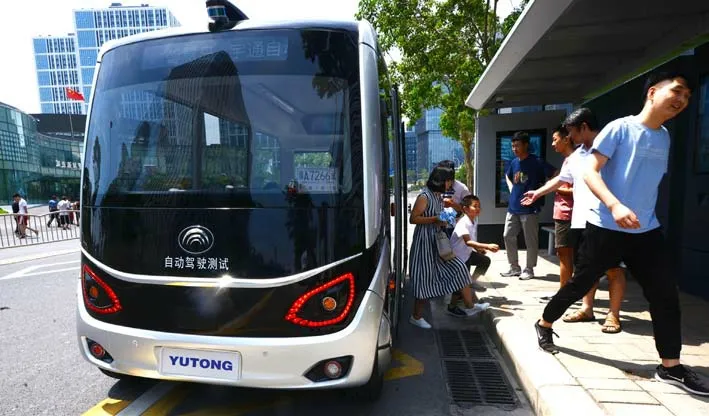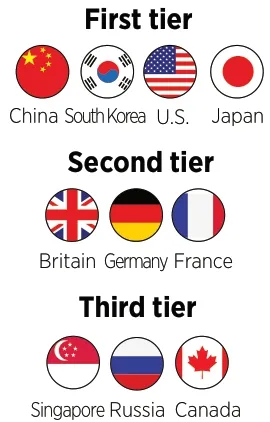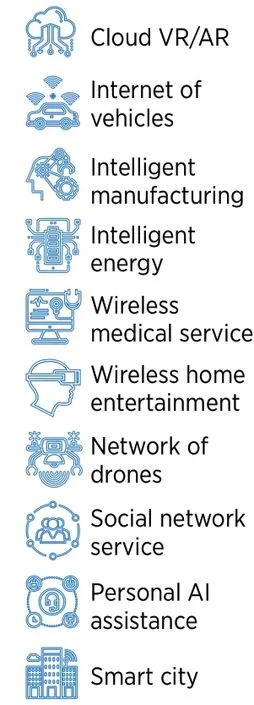BRACING FOR THE 5G ERA
By Yuan Yanan
China widens its embrace of 5G with commercial use licensing
O n June 20, 2019, a case of copyright infringement was publicly heard at the Court of Siming District in Xiamen City,southeastern China's Fujian Province.The hearing was broadcast live online with the help of 5G technologies—a first for China.
The live broadcast was jointly carried out by more than 40 media organizations and watched by 12 million netizens. The court was equipped with virtual reality (VR)cameras capable of capturing 360-degree video of the hearing.Netizens could watch the live broadcast via mobile phones and change the angle of view just by moving their fingers across the screen. Thanks to 5G technologies, the live broadcast produced not only high-resolution images but also near zero latency.

5G-driven smart home and Internet of Things technologies under the spotlight at the 7th China Information Technology Expo held in Shenzhen in April 2019.
On June 6, two weeks before the live broadcast, China's Ministry of Industry and Information Technology (MIIT)issued 5G commercial use licenses to four major telecom carriers, China Telecom, China Mobile, China Unicom and China Broadcasting Network,marking the dawn of 5G commercial use in China. One of the first pilot cities for 5G commercial use, Xiamen has adopted 5G technologies in areas such as medical care, education and transport. It will soon be the norm to watch a 360-degree live broadcast.
The 5G era is arriving with the breakout of commercial use. Many enterprises are trying to grab a piece of the potentially huge market pie.After the MIIT issued the 5G licenses,smartphone manufacturers such as Huawei, Xiaomi and ZTE all announced that they would release 5G mobile phones in the second half of 2019.China Mobile, one of the three major mobile operators in China, announced on June 20 that it would provide 5G services in more than 40 cities before the end of September 2019, enabling consumers to enjoy the much faster 5G speed without the need to change SIM cards or phone numbers.
“Across the past three centuries since the first industrial revolution,5G could compare to the steam engine or introduction of electricity, with unimaginable potential to amplify,strengthening and boosting economic and social development,” remarked Yang Guang, general manager of the Department of Industrial and Service Cooperation at China Mobile Research Institute.
A report released by China Academy of Information and Communications Technology (CAICT) predicts that from 2020 to 2025, commercial use of 5G will directly stimulate 10.6 trillion yuan of economic output and 24.8 trillion yuan of indirect economic output and create more than 3 million jobs in China. 4G has changed people's lives, and 5G will change all of society.
The 5G era is arriving with the breakout of commercial use. Many enterprises are trying to grab a piece of the potentially huge market pie.
Three Major Application Scenarios
5G is more than just faster speeds of data transmission. Wen Ku,director general of the Department of Information and Communication Development under the MIIT, noted that 5G features enhanced broadband,massive connections, low latency and high reliability which can provide platforms for building technological networks such as the Internet of Things (IoT) and artificial intelligence(AI) and support the development of various trans-sectoral integrations and applications.
The international standardization organization 3GPP defined three main application scenarios for 5G: Enhanced Mobile Broadband (eMBB), Massive Machine Type Communication(mMTC) and Ultra-reliable Low-latency Communications (URLLC), through which we can glance at the changes 5G will bring to our lives.
First, eMBB.In a 5G network,perhaps the most noticeable change consumers may feel is much faster speed. It will take only three seconds to download a 1G movie. Theoretically,the maximum download speed of 4G is 150Mbps, but that of a 5G base station can reach 20Gbps. That means every individual user can enjoy a download speed of 1Gbps, providing better user experience for video watching and downloading. According to Wen Xiaojun, secretary-general of China UHD Video Industry Alliance, ultrahigh-resolution video may be the first area for 5G application during the stage of its trial commercial use and the earliest area in which mobile operators can earn returns on their investment.
Sharply increased speeds can generate new market opportunities.For instance, live video broadcasting will become easier in the 5G era, and everyone will be able to become a mobile “television station.” With the help of 5G, major breakthroughs will be made in the VR industry. Xiang Ligang,a Chinese analyst in the telecom industry, noted that the transmission of high-resolution VR videos requires a bandwidth with a speed of at least 150Mbps, which has been impossible in the 4G era. 5G will significantly enhance the VR user experience,creating new opportunities for the industry.
Second, eMTC.Like the VR industry,the IoT was just a fancy dream before the arrival of the 5G era. Wang Zhiqin,vice president of CAICT, remarked that while 4G was leveraged largely in the consumer internet, 5G will usher in an era of the “Internet of Everything.”
One of the most important breakthroughs of 5G is that it transcends person-to-person communications to make manmachine and machine-machine communications possible. In his book The 5G Era, Xiang Ligang described his vision of the future: When you arrive home after work, smart airconditioners and smart lamps turn on automatically and adjust to a pleasant level according to your body temperature. The smart microwave oven begins to heat your dinner. After the dinner, the bathtub gets water ready at just the temperature you want.A smart toothbrush monitors your oral health condition. If you need to go out,the garage door opens automatically,and a self-driving car takes you to your destination. Although it will still take some time for such technologies to reach consumers, the future of smart homes is closer than ever in the 5G era.
The 2016 Global Connectivity Index released by Huawei predicted that the number of connected IoT terminals would reach 100 billion by 2025, and 2 million sensors would be deployed every hour. Such massive connection population demands a very capable network featuring low energy consumption. 5G provides infinite possibilities.
Third, URLLC.The Internet of Vehicles (IoV) is a priority area for 5G application. “IoV is perhaps the largest market for mobile IoT,” declared Miao Wei, minister of the MIIT, at the 2019 Annual Conference of the Boao Forum for Asia. “Self-driving cars will likely be one of the first 5G applications.”
Long before commercial use of 5G, many carmakers were already competing for the IoV market.Issuance of 5G commercial use licenses in China will accelerate the development of the entire industry.Compared to its predecessors, 5G boasts much lower latency. The latency of 3G networks is about 100 milliseconds, which dropped to 20 to 80 milliseconds in the 4G era. The theoretical latency of 5G networks is as low as only a millisecond, and the braking distance of a motor vehicle is only 17 millimeters per millisecond.That means the ultralow latency of 5G can maximally reduce risk when a selfdriving car runs at a high speed.

Kotovs Pavels from Latvia interacts with a 5G-based humanoid robot in the China Mobile booth at the first China-CEEC Expo in Ningbo, Zhejiang Province, on June 9, 2019.

Residents take a 5G-enabled self-driving bus in trial operation in Longzihu Smart Island in Zhengzhou, capital of Henan Province.
5G will also serve as a booster for the industrial IoT. For a long time,industrial IoT was confined to data collection and display and extended management functions and still hasn't reached core areas such as control of the industrial system primarily because the stability and latency of existing communications networks fail to meet requirements. The ultralow latency of 5G can guarantee real-time monitoring and control in the industrial field.
Its highly reliable network can meet industry's requirements for stability and its broad bandwidth can support high-resolution 3D video transmission,considerably enhancing the accuracy of remote control. Sooner or later, 5G will empower industrial IoT in a big way.
China's Advantages in 5G Development
China isn't the first country tocommence commercial use of 5G, and a few countries including South Korea and the United States have led in issuing 5G commercial use licenses.

Global forerunners in 5G development

Contribution rates to key technologies of the 5G standards

Source: White paper “Top 10 5G Use Cases” released by Huawei

For more information, please scan the QR code.
However, China has been a clear frontrunner in 5G development globally.
After it launched 5G trials in January 2016, China took only three and a half years to achieve commercial use. Wu Hequan,an academician at the Chinese Academy of Engineering,believes China is well prepared in terms of technology and industry, and conditions are ripe for the country to launch 5G commercial use.
In early April of this year,the U.S. Department of Defense released a report titled The 5G Ecosystem: Risks & Opportunities for DoD. The report lists China,South Korea, Japan and the United States as the “first tier”in 5G development, Britain,Germany and France as the“second tier,” and Singapore,Russia and Canada as the “third tier.”
Although both were listed in the “first tier,” China has obvious superiority over the United States in terms of 5G development. According to Gong Daning, a senior engineer at the Policy and Economics Research Institute of CAICT, China insists on integrating innovation and openness and has gained competitive advantages in 5G technology, standards and industrial development. In terms of technical standards,the 5G concepts, application scenarios and technical index that China advocates have been incorporated into the 5G definition of the International Telecommunication Union(ITU), and the key technologies developed by Chinese enterprises such as flexible system design, polar codes,massive MIMO and new network architecture have become important components of the international 5G standards.By May 2019, companies from China accounted for 30 percent of essential patents related to the 5G standards, ranking first in the world.
China also takes the lead in 5G industrial development.Yang Hua, secretary-general of China's Telecommunication Development Industry Alliance, noted that Chinese wireless products, whether for standalone networks or non-standalone networks,outperformed their foreign counterparts in tests. Moreover,Chinese products boast great cost performance.
The latest 5G patent report released by Germany's patent statistics company IPlytics indicates that by April 2019,Chinese companies accounted for 36 percent of all 5G standardessential patents applied,ranking first globally, of which Huawei owned 15 percent of all applied patents, becoming the world's leader in this regard.Despite unfair treatment from the U.S. government, Huawei has still earned recognition from most countries in the world for its quality products. By June 25, 2019, the Chinese telecom giant had won 50 contracts for 5G commercial use around the world and shipped 150,000 sets of 5G equipment. Among Southeast Asian countries,the Philippines became the first to open a 5G network for commercial use, with core equipment supplied by Huawei.In the second quarter of 2019,Huawei helped the Philippines complete construction of 5G networks for household users.By 2020, 5G networks are expected to be available across the Philippines.
China's huge market has injected great impetus into 5G development in the country.China has a population of nearly 1.4 billion, and its consumers have a strong demand for telecommunication products and services. Due to the country's high population density, the cost for building communications infrastructure is relatively low, increasing the business value and profit potential of its telecommunication industry.This advantage is incomparable to any other country except India. The huge potential for profits will encourage enterprises to increase their investments.
The Chinese government is also clearly inclined to encourage 5G development.Construction of 5G networks is a massive systematic project. The efforts of enterprises alone are far from enough—support from the government is particularly crucial. The “Internet Power”initiative has been raised to a national development strategy of China, and 5G development is a key step in implementing the strategy.
In general, China's overall strength gives it advantages in leading global 5G development.However, many practical problems still need to be addressed.
According to Wu Hequan,it will take 8 to 10 years to complete construction of basic 5G networks. Moreover, mobile operators will need to invest about a trillion yuan, a huge burden. Other bottlenecks such as development of core technologies, location selection of base stations and distribution of spectrum resources must be overcome one by one.
With the launch of commercial use, 5G has begun to face market tests.

